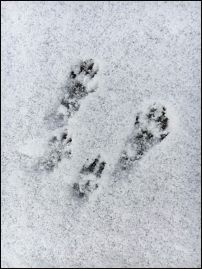 Naturalist Megan Giefer goes on a winter adventure:
Naturalist Megan Giefer goes on a winter adventure:
Have you ever wondered what footprints you are peering at in the white, fluffy snow? During this time of year, we know that animals are making their presence, but now we can see what is crawling around. The tracks in the snow can tell us many stories: from the distance an animal is traveling to a chase between a rabbit and a barred owl that could have an unfortunate ending.
It’s a bright sunny morning; I’m taking that first step outside and breathing in the cold Wisconsin air, and there are footprints scattered everywhere, as if animals were playing a game of tag in the snow along my walk to the Nature Center here at Upham Woods. In Wisconsin, some of the footprints you might be witnessing are: rabbits, squirrels, deer, turkeys, song birds, fox, and coyotes.
Squirrels are always crawling around the landscape with their small prints (as seen in the picture above). In the winter time, these fuzzy little creatures are homeotherms, which means that they remain a constant body temperature throughout the entire year. One way squirrels stay warm is by shivering, they shiver to generate body heat to keep a nice, toasty temperature throughout the cold months. During the winter, squirrels rely on their food storage underground, but almost half the time they forget about it.
Deer are one of the most recognizable tracks to find in the winter time; with their two hooved prints. During this time of year, deer are starting to bundle up and getting physically prepared for the cold weather by trading in their summer jacket for a nice, thick winter coat. The thick coat allows sunlight to absorb and the fur traps the heat inside creating warm insulation. Deer are less active in the winter by slowing down their metabolism by almost half to save energy and by also eating less. Their diet consists of twigs, buds, stems, and grasses.
One of the canines you might see during this cold season is a coyote. To identify their prints, you want to peer for four toe pads and little claw marks right above those pads. It’s easy to become confused with the prints of a feline and a canine, but canines will always have claw marks at the top of the pads and felines are able to retract their claws making them not appear in the snow.
Be sure to look out for these beautiful creatures’ prints next time you step outside!



